Not all building envelope issues are obvious at first glance. In this case study, we’ll demonstrate how WCP identified serious structural concerns hiding beneath what looked like fairly common cosmetic issues. Campbell Heights Business Park in South Surrey, BC, has grown into one of British Columbia’s most important industrial hubs. Envisioned as strategic employment land in the early 2000s, it now supports over 2.4 million square feet of warehousing, light manufacturing, and logistics space with employers like Amazon, Walmart, DHL, Greenline Hose & Fittings, Tromlite, and Skechers calling it home.
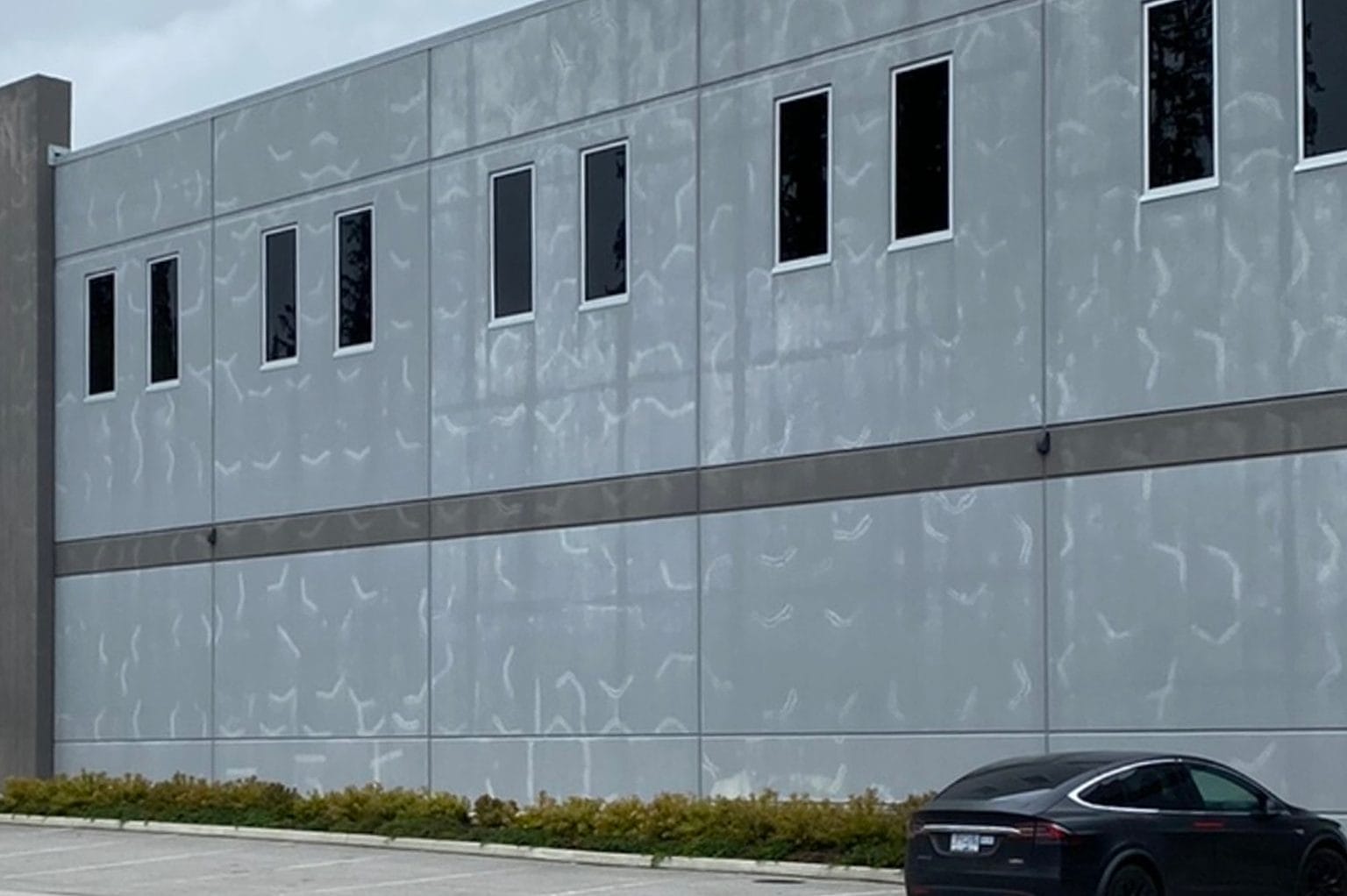
Spanning nearly 2,000 acres, this master-planned district is projected to be home to 20,500 jobs, making it a cornerstone of Surrey’s economic future.
But even the biggest and most important facilities aren’t immune to building envelope challenges.
In the late autumn of 2023, our team was contacted to assess a series of chalky “crop circle” stains that began appearing on the exterior walls of a large warehouse complex in the business park.
By the client’s description, it sounded like textbook efflorescence, but the scale of the patterns raised red flags for us, suggesting there could be something more serious going on.
On its own, efflorescence (a white, powdery deposit on the concrete) is mostly cosmetic. But when it shows up in large, repeating areas like the “crop circles” described by our client, it’s often a symptom of deeper water-related issues.
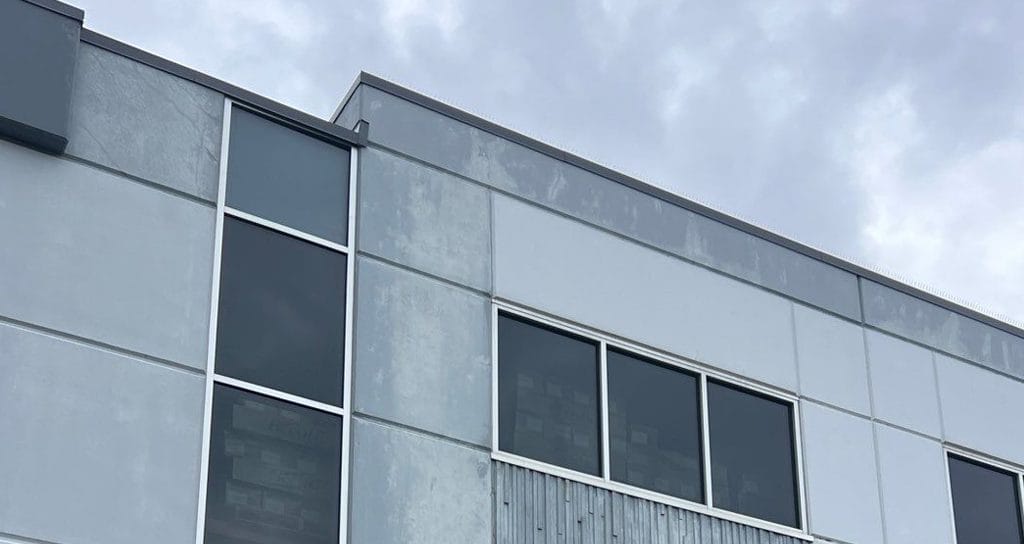
Investigation and Diagnosis
When we came out to address the client’s concerns, what we found was the most severe case of efflorescence we had encountered in over 20 years.
Our investigation uncovered a host of widespread and potentially dangerous issues like delaminated joints, substrate cracks, cold joint failures, and complete coating failures.
The white rings described by the client were radiating outward from the dowels used to tie the concrete wall panels together. In some places, the efflorescence buildup had become so aggressive that it etched through the coating system entirely, exposing bare concrete beneath.
During the initial walkthrough, we also uncovered a range of compounding issues: delaminated expansion joints, cold joint failures, active cracks, spalled areas, and widespread coating adhesion failures. Many of these issues were either masked by the efflorescence or had gone unnoticed due to the size of the property.
Initially, the efflorescence was the client’s main concern, but now it was clear there were much bigger issues to address.
We were skeptical that conventional treatment methods would be effective at this scale. To ensure a durable solution given the scale and severity of the problem, we developed a testing program that involved four different washing treatments, primers, and coating systems. We applied each system to designated test areas on the site and monitored their performance over a full winter weather cycle.
By the following spring, two of the four systems had proven their durability, holding up against freeze-thaw cycles, heavy precipitation, and UV exposure. With this data in hand, we could confidently create and finalize our restoration plan.
During this test phase, we also decided it was necessary to perform several emergency repairs at critical expansion joints and cold joints to address immediate water ingress concerns and prevent further deterioration over the wet Lower Mainland winter.
Scope of work and restoration strategy: What we found, and how we fixed it.
What began as a fairly common efflorescence issue had now turned out to be just the tip of (a very big, 500,000 sq ft) iceberg. It soon became clear that a comprehensive, multi-trade repair strategy would be needed. From structural steel repairs to concrete polishing and waterproofing, this restoration was going to require careful coordination, specialized trades, and a well-planned strategy. Here’s what was involved, and how we tackled each of the major issues found:
Concrete repairs in detail
Efflorescence treatment and removal
To address this comparatively simpler issue, we tested a number of systems and ultimately selected a biodegradable detergent solution to neutralize the efflorescence. This eco-friendly option was chosen in part because it gave us full confidence that it wouldn’t etch or ruin the building’s glass (a concern with harsher, conventional cleaners). Once neutralized, the affected areas were thoroughly power-washed to remove any remaining residue. We then applied an alkali-resistant primer to block further migration of efflorescence through the surface.
Crack chasing and repair
Crack chasing is a technique used to repair cracks in concrete walls and floors. For this, we use a grinder or saw fitted with a V-shaped diamond blade to cut along the path of an existing crack to slightly widen and deepen it, creating a clean, uniform channel that will allow for proper adhesion of repair materials.
We discovered roughly 3000 linear feet of cracks to be chased throughout the complex. (That might sound more fun than it actually is)
Once the crack is “chased”, the new groove is cleaned out, and then filled with a flexible sealant or epoxy. This process helps stop future water intrusion, restores surface integrity, and prevents further concrete deterioration.

Cold joint repairs
Cold joints occur when fresh concrete is poured next to concrete that has already cured, which means there isn’t a proper bond between the two pours. The joint between the two pours can become a point of weakness, allowing moisture infiltration and eventually compromising the structure’s integrity if not properly treated.
We discovered multiple instances through the complex where cold joints were failing and allowing water ingress. Our repair process involved:
- Chasing the joint to open up and expose the interface.
- Removing loose material and contaminants, then cleaning the joint.
- Installing a flexible backer rod where required.
- Applying a high-performance joint sealant to both sides of the joint.
Where larger structural concerns were identified, we also used epoxy injection or repair mortars to re-establish a structural bond between sections of concrete. The repaired joints were then finished to match the existing surrounding surfaces.
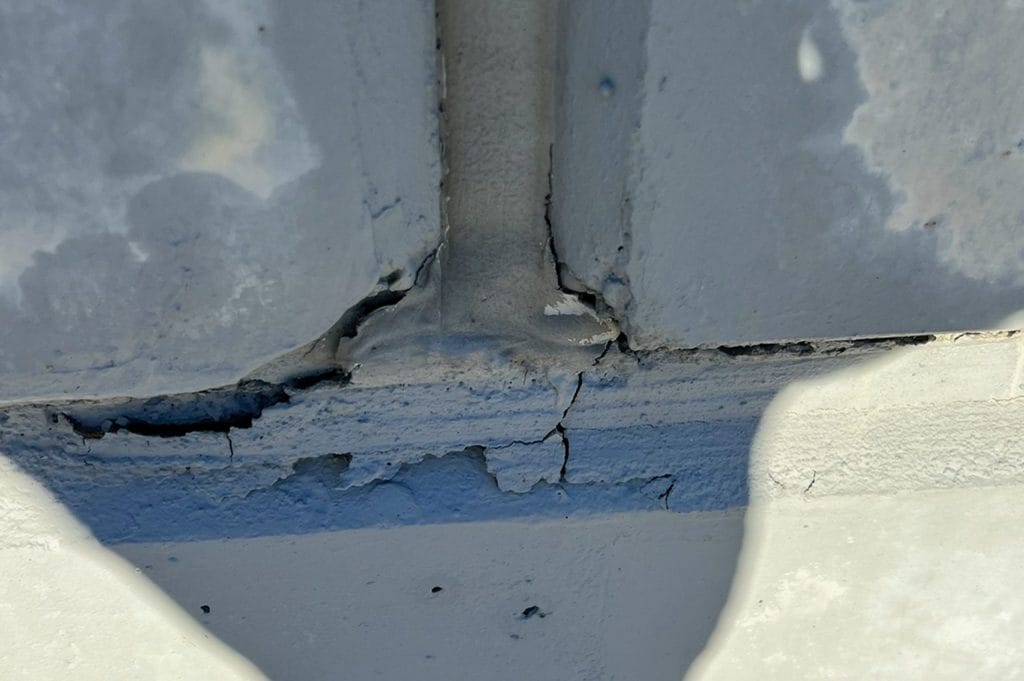
Expansion Joint Replacement
Expansion joints are essential components in concrete and structural construction. Their primary purpose is to absorb movement caused by seasonal temperature changes, moisture, seismic activity, and building settlement. Without them, concrete will likely crack or spall under stress.
These joints are filled with flexible materials that compress and stretch as the building shifts (like a giant rubber bumper between slabs of unforgiving concrete). In large warehouses like the ones at Campbell Heights, they’re essential for protecting structural integrity.
Over time, expansion joint materials can break down, allowing water to seep in and cause damage. Replacing them restores the necessary flexibility needed to prevent cracks and leaks, and helps extend the life of the building.
For approximately 50% of the expansion joints in the complex, we had to carry out full removal of the old failing sealant and replacement. This included cleaning the concrete substrate, installing new backer rods, and tooling in new polyurethane sealant with a professional finish to ensure a long-lasting, watertight seal.
Concrete spalling repairs
Concrete spalling is when the surface of the concrete chips off or breaks away, exposing the steel rebar underneath. It’s usually caused by moisture migrating deep into the concrete and rusting the rebar, which then expands, cracking and damaging the surrounding concrete. Once started, spalling only gets worse with time and can lead to bigger repairs if not addressed early.
We discovered spalling was occurring at numerous locations throughout the complex, with large sections of concrete either already dislodged or actively failing. We began by diamond-cutting around the perimeters of the affected areas, then removed all the loose and deteriorated concrete using Hilti tools.
Where necessary, we repaired and treated the exposed rebar to restore its structural integrity. The surfaces were then reinstated using a fibre-reinforced, form-and-pour concrete repair mortar, and finally, each repaired area was ground down and finished to blend seamlessly with the existing surface texture and profile.
Structural steel repairs
Several structural steel awnings throughout the complex had significant coating failure and visible corrosion. To address this, we mechanically ground the steel back to bare metal, removing all previous failed coatings and surface rust.
Once prepped, we applied an industrial rust-inhibitive primer to protect against future corrosion. This was followed by two coats of industrial-grade urethane enamel, providing a durable, long-term protective finish suitable for exterior exposure.

Concrete polishing
Concrete polishing is a multi-step process that basically smooths the concrete surface by using progressively finer grinding tools. This enhances durability, removes surface imperfections, and leaves a cleaner, smoother finish that’s easy to maintain.
In some areas, the existing coating system had deteriorated to the point of having little or no adhesion to the original concrete substrate. In these damaged areas, we used a concrete polishing process to fully remove the failing coating system.
This involved specialized grinders and HEPA-filtered vacuums to safely capture dust while grinding all the way down to bare concrete. The grinding process also produced a light profile on the concrete surface, which allowed the primer to mechanically bond, resulting in exceptional adhesion of the new coating system.
Final results and long-term protection.
The final step: a new coating system. Not just aesthetically pleasing, this final process seals, protects, and unifies the repaired surfaces with the rest of the building’s surfaces, providing long-term durability.
Remember that special coating systems test we performed the previous winter? The winner was Gripper Primer, followed by two full finish coats of Dulux Diamond Satin Finish.
A project of massive proportions
So what does it take to restore a complex of this size? In a word: coordination. With crews using bikes to move around the site and keep up with the workload, this project tested the limits of logistics and endurance.
Here’s a snapshot of the scope, scale, and numbers behind the transformation.
- Over 350,000 square feet of wall surface repaired and restored
- 14,000 linear feet of expansion joints replaced
- 3000 linear feet of concrete cracks chased and repaired
- 600 square feet of concrete spalls repaired
- Over 5,000 square feet of concrete polishing
- Applied over 1250 gallons of primer and 2000 gallons of paint
- Over 13,000 linear feet of structural steel repaired and restored
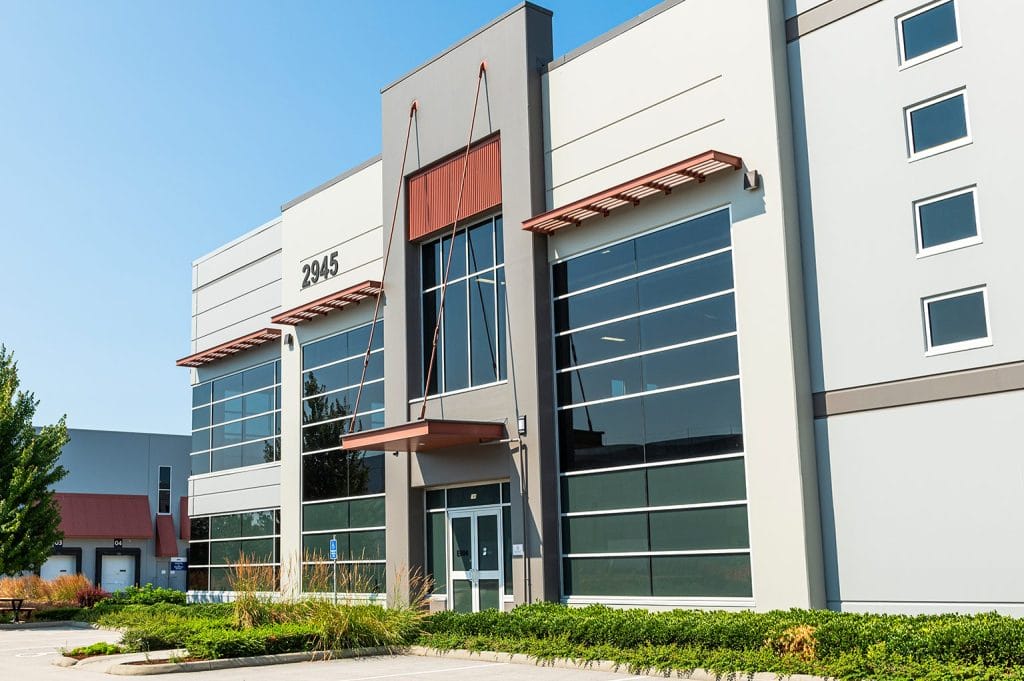
Results we’re proud of
Warehouse restoration results and impact
Over the course of two exterior seasons, we fully restored the Campbell Heights complex to like-new condition (or better) despite the building being just four years old. More importantly, we were able to provide our client with the peace of mind knowing they have a long-term protective solution that will serve for years to come.
Shortly after completion, the property was successfully sold, with our restoration work playing a key role in both its marketability and overall value.
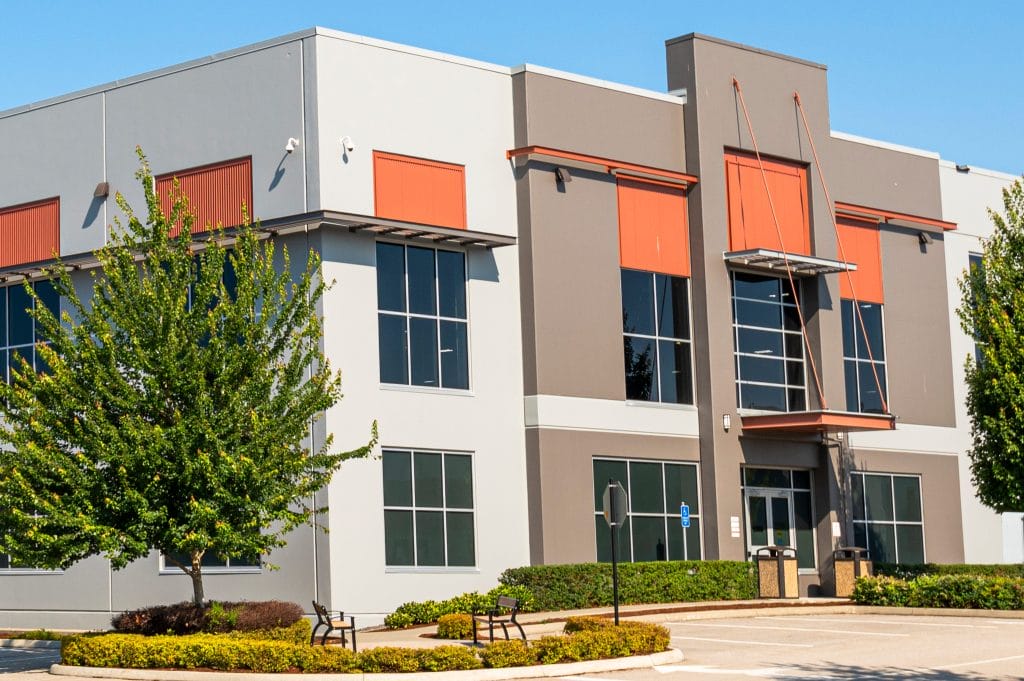
Peace of mind is included in every project
At WCP, our work doesn’t end when the scaffolding comes down and the crews go home. With a project as complex and far-reaching as Campbell Heights, long-term performance and support are everything. That’s why we back our work with our industry-leading WCP PROTECH Warranty & Maintenance Program.
- Up to 5 years of warranty coverage
- 2-year maintenance follow-ups
- A detailed completion and maintenance manual
It’s more than just a warranty; it’s our way of providing peace of mind that the investment you’ve made in your building will continue to pay off well into the future.
Need help with warehouse or commercial concrete issues?
WCP specializes in industrial building restoration, including concrete spalling, expansion joint replacement, and envelope repair.
For more information on these and our other services, contact us at [email protected] or call us at 604-420-5552.
Protect your property and plan with confidence. Reach out today for a free, no-obligation quote.


